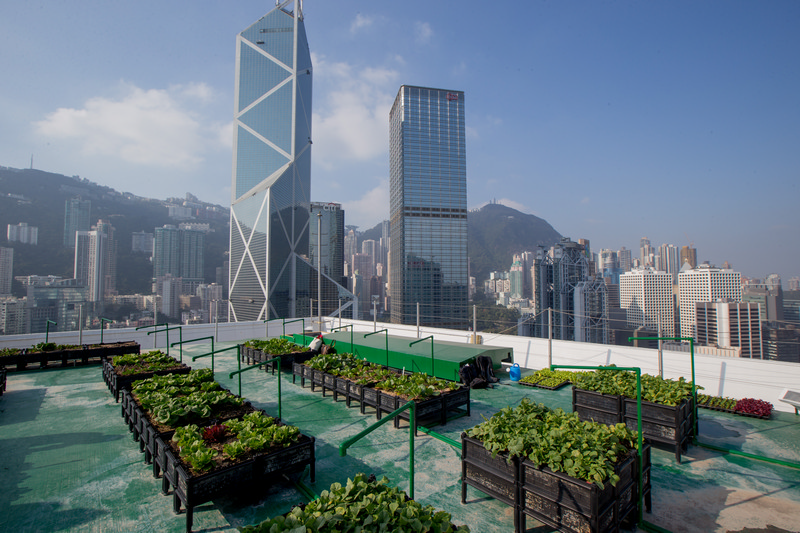
Finding Hong Kong’s new crop of urban farmers
Can agriculture and urban growth find a way to coexist? A new generation of urban farmers is reinventing the meaning of concrete jungle in Hong Kong

Care for a Malaysian durian? That will be HK$600, please. Too expensive? How about Tasmanian cherries? HK$550 only. These were the going rates of ‘exotic’ fruits at the Yau Ma Tei market in last year’s expensive fruit fad, which made news all over the world.
“On the shelves of City Super, a single Japanese strawberry recently fetched a whopping HK$168,” reported AFP. “Each strawberry was nestled on a paper pillow, encased in a glossy cardboard box.” The “appetite for pricey fruit from far afield” reflected “a quest for clean, fresh produce” from anywhere but China.
Food safety and contamination have been sources of concern and alarm in Hong Kong and China in recent history. The 2008 milk scandal in China’s Gansu Province terrorised young parents when toxic melamine was found in baby milk powder. Last year, Hong Kong faced a shortage when livestock from Jiangxi (supplying 20% of the city’s pork) was found to be tainted with illegal food additives: asthma drugs used to artificially enhance growth and leanness. These scares have driven local consumers to take action and become more vigilant about the sourcing of their produce; “never mind the extra cost, as long as I’m sure it won’t kill me.”

Back to nature
Hong Kong’s return to farming has been driven in part by such food safety issues. Up north, in the New Territories, ‘rural’ farming was once thought to have become extinct. Little over a decade ago, there was barely any agricultural activity to be found in those parts. However, in the last ten years organic farms have resurged, and today they number in the hundreds – closer to 500 and growing.
“I tried to work in the city for almost three years, but I hated it,” says Becky Au, who runs the Ma Po Po Community Farm in Fanling. “I realized that I want a job that is close to nature and to my home. Some of my friends suggested that I should build a farm… so why not?”
In 2011, Becky Au was in the midst of a Post-80s movement that saw a return to farming amongst Hong Kong’s denizens disillusioned by corporate life. [Post-’80 refers to the generation born between 1980 and 1989 after the death of Mao Zedong and the introduction of the One-child policy]. In an interview with Emily Wu for now defunct HK Magazine, Becky told her tale of growing up on a farm in Ma Shi Po, getting a job in the city and then choosing to go back to her roots.
According to Becky, she feels luckier than her peers as she gets to “eat the best and freshest food” nurtured by her own hand. “I have everything I need here,” she says.

Sky’s the limit
Meanwhile, on top of one of Central’s iconic skyscrapers, a decommissioned helicopter helipad enjoys a new lease on life thanks to Rooftop Republic, a local social enterprise. The five-year-old company provides agricultural services to rooftops all over Hong Kong’s concrete jungle, including the stunning site on the 39th floor of the Bank of America Tower.
“I realised the potential of urban farming to transform the way we currently grow, consume and think about food,” says Rooftop Republic co-founder Pol Fàbrega. The sky-high farm rotates crops by season: sweet potatoes and Chinese spinach in the summer, and radishes, lettuce and kale in winter. The team sometimes donates its harvests to a local food bank where it’s cooked and sent to the poor.
Now with 34 similar projects in Hong Kong, Rooftop Republic has gone a long way since 2012. Businesses have been hiring them for services from site assessment and customised farm design to seedling delivery and edible green wall installations. Everyday folks are also invited to participate; the company holds events on a regular basis, such as urban farming for kids, microgreens workshops and nutrition talks.

The future of agriculture?
According to Matthew Pryor at the Division of Landscape Architecture at the University of Hong Kong (HKU), there are around 60 such rooftop farms in the city. Pryor is currently working on a model estimating the total space for potential rooftop farms in the SAR. “There’s more on the roof than there is on the ground,” he says.
Pryor, a landscape architect, hopes to persuade the government to integrate rooftop farms into city planning. He reasons out that green ceilings can provide thermal and sound insulation, potentially saving buildings’ overall energy consumption. If you want to see proof of concept, you can visit his rooftop farm in HKU, which he founded with fellow staff and students out of recycled materials from construction sites.

Many may tout indoor / vertical / urban agriculture as nothing but a passing fad, but those in the know stand their ground on it being inseparable from the future of humanity. “With hundreds of millions suffering from under-nutrition, anything that helps to bring nutritious food closer to the urban table can only be worth pursuing,” says Laurie Winkless, physicist and science writer.
In 2015 science fiction film The Martian, Matt Damon plays a botanist who survives being stranded on Mars by cultivating potatoes on his rocket ship. It presents an interesting scenario: can the technology we are using for urban farming today be employed beyond the confines of earth one day? We wouldn’t be surprised if Elon Musk’s SpaceX were to onboard some of the budding hydroponic experts on his quest to colonise the red planet – would you?
Written by: Julienne C. Raboca







